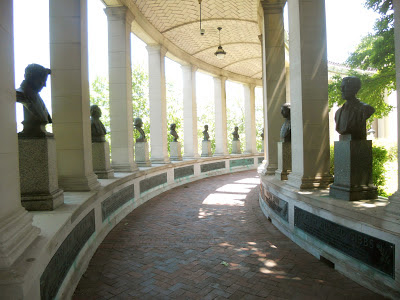Bronx Community College
University Heights, the
Bronx
When asked to name a
prominent university in New York City, most individuals would likely identify
New York University or Columbia. Both NYU and Columbia are prestigious institutions with
dreadfully long, esteemed histories. Their campuses are resplendent with the
sort of Neoclassical architecture that assures parents paying their child’s
hefty tuition that their progeny are attending houses of true learning. Their
private art collections are a name-dropper’s wet dream and (in the case of
Columbia) the lawn is perfectly manicured.
I doubt anyone would ever
list Bronx Community College as one of NYC’s elite institutions of higher
learning, yet it possesses a surprisingly large number of beaux-arts edifices
that were designed by the celebrated 19th-century architect Stanford
White. The architecture firm of McKim, Mead, & White was responsible for
such gems as NYC’s original (and tragically demolished) Penn Station, the
Washington Square Park Arch, and Tiffany and Company. Equally surprising is
that one of the structures constructed by White at BCC is a 630-foot open-air
colonnade filled with almost 100 bronze portrait busts, some of which were made
by the same artists who made sculptures for the Lincoln Memorial, the U.S.
Supreme Court, and the White-designed Washington Square Park Arch.
The mystery is cleared up
when one learns that the campus that is now owned by BCC originally housed NYU’s
undergraduate college and now-defunct engineering school. The University
Heights campus was founded in 1894 as a way to alleviate overcrowding from its
Washington Heights campus. But when NYC’s financial crisis of the 1960s and
1970s threatened to bankrupt the school, New York University sold the campus to
the City University of New York in 1973.
So, it was NYU’s striving
for greatness that led to a small community college branch of CUNY to be in
possession of four buildings designed by White and become the first community college in the country to be designated a National Historic Landmark. The campus isn’t all arches,
domes, and columns though. NYU also commissioned Marcel Breuer (the Bauhaus
architect of Whitney Museum and Wassily Chair fame) to create four brutalist concrete
buildings, which are some of the most depressing residence and lecture halls
ever to grace a college campus. Sometimes there are prices to pay for always
hiring the latest trendsetter; not all styles age well.
For those of you who
think the Hall of Fame for Great Americans sounds like just about the most
boring thing ever, let me assure you that it is surprisingly captivating. I,
too, had my doubts. I thought I’d be in and out in a few minutes but ended up
staying almost an hour, and then continued the wandering throughout the rest of
the campus. There’s an element of pure high school history class geek enjoyment
in seeing which Great Americans NYU chose to induct into the Hall of Fame.
They’re even divided into categories to help you figure out who they are
(inventors, statesmen, soldiers, academics, writers), and each bust is
accompanied by a personal quote meant to epitomize their place in history.
There are spaces for 102 busts, but four of the slots remain open as no
Americans have been inducted since the property switched hands in 1973. If BCC
ever decided to fill the remaining spaces, I’d be very curious who’d they
elect.
I’m not going to lie to
you: unless you live in along the western part of the Bronx or Upper Manhattan,
getting to BCC is a pain in the ass. And we all know the Bronx isn’t what it
used to be (Thank you very much, Robert Moses.). You can get the 4-train to
Burnside in the Bronx, the Bx12 bus from Upper Manhattan, or even the
Metro-North to University Heights. If you decide to make a trip that combines
touring BCC along with a visit to the University Woods park next door to the
campus, you know you’re going to spend the entire time in the park stumbling
upon the make-shift abodes of homeless persons and trying to avoid the
ever-present aroma of urine. Hardly a relaxing stroll through the woods. Instead,
you may want to combine it with a trip to the nearby Edgar Allen Poe Cottage or
the not-as-far-as-you-think Arthur Avenue, home of Bronx’s Little Italy, which
has survived much better than the one downtown thanks to the lack of an
ever-encroaching Chinatown.
The best time to make a
journey to BCC to explore its surprising architecture and monuments (including
several rusty Revolutionary War canons) is a weekend or anytime when classes
are not in session. Just make sure the campus is open; you’d hate to be turned
away at the gate after going to so much trouble to get there. I imagine it
would be much harder to leisurely stroll the grounds and admire the bronzed
Americans surrounded by its very rowdy student body. I teach at BMCC, one of
BCC’s sister community colleges, and there are few places to find respite on,
say, a Tuesday afternoon in the middle of the semester. Although, if you go
when school is in session, you might be able to peak inside the fabulous domed
library.






No comments:
Post a Comment